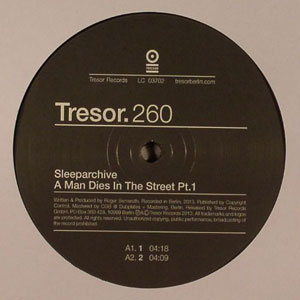Sleeparchive A Man Dies in the Street Pt. 1
For many years, Roger Semsroth claimed that his Sleeparchive project would only release material on […]

For many years, Roger Semsroth claimed that his Sleeparchive project would only release material on its own eponymous label—and, for much of the aughts, it was like that. It took seminal techno imprint Tresor getting involved for him to try another outlet. On paper, it’s a perfect pairing, as both entities are invested in the kind of heavy, countercultural ethos championed by the likes of Underground Resistance in the ’90s. But so far, there just hasn’t been that much material, with only one release, Ronan Point, since the dawn of the new decade. Much like that EP, A Man Dies in the Street Pt. 1, his first offering since, is an exercise in what it means to make practical, no-frills techno loops.
Like many prior Sleeparchive EPs, his latest is programmatic in nature. It’s named after a photo series by Hungarian-born photographer George Brassaï, an artist best known for his surrealistically framed shots of life in the underbelly of pre-WWII Paris. A Man Dies in the Street is exactly what it says it is, with eight shots depicting the aftermath of a sudden death that includes rubberneckers, an ambulance, and eventually, an empty sidewalk. The most important thing, however, is the vantage; Brassaï documents the action from the detached perspective of an apartment window high above, lending his work a weirdly objective matter-of-factness.
Semsroth’s four tracks have much of the same feeling, even though not much of the content recalls the source material specifically. “1” starts out with a heavy kick and an EBM bass riff in the vein of early Nitzer Ebb. “2” pulls the low end out, throws in some background noise, and lets a bleeping synth lead take the reigns. “3” takes a tougher angle, with a pummeling kick drum and crunchy, arpeggiating bass. “4” applies some Basic Channel atmospherics, letting a lead ostinato echo out over sizzling tape hiss. All of these musical ideas manage to convey a general sense of dread, which is repeated in each instance without any real variation to speak of. Instead, a nearly static loop is expressed, allowed to run for four minutes, and then brutally cut off. This lack of complexity does become grating in a non-club setting, but it makes for good material in a DJ set—and that seems to be entirely the intention.

